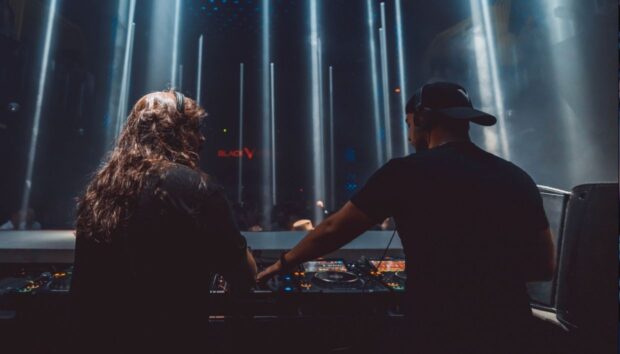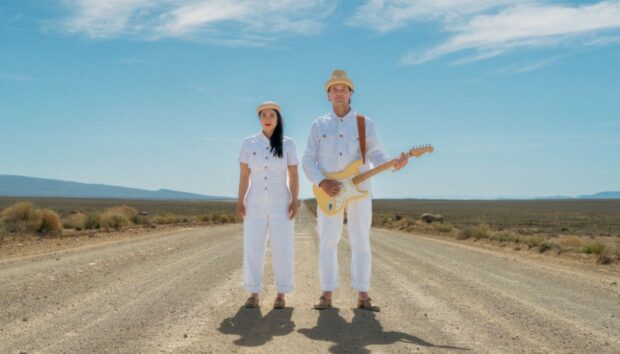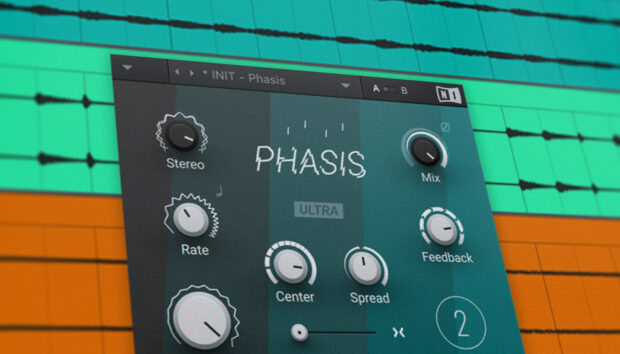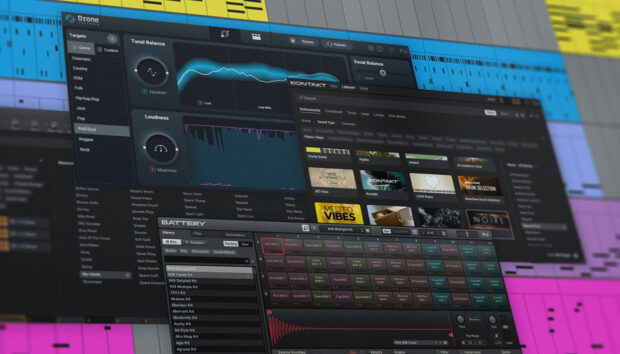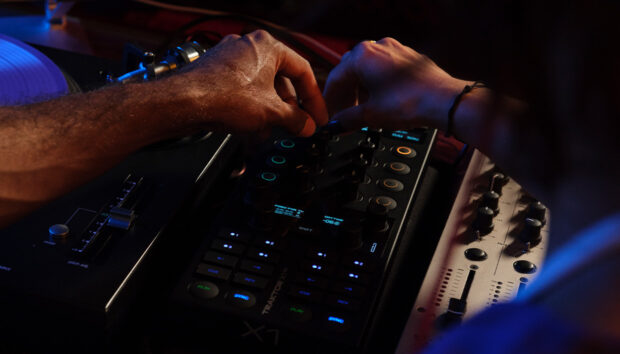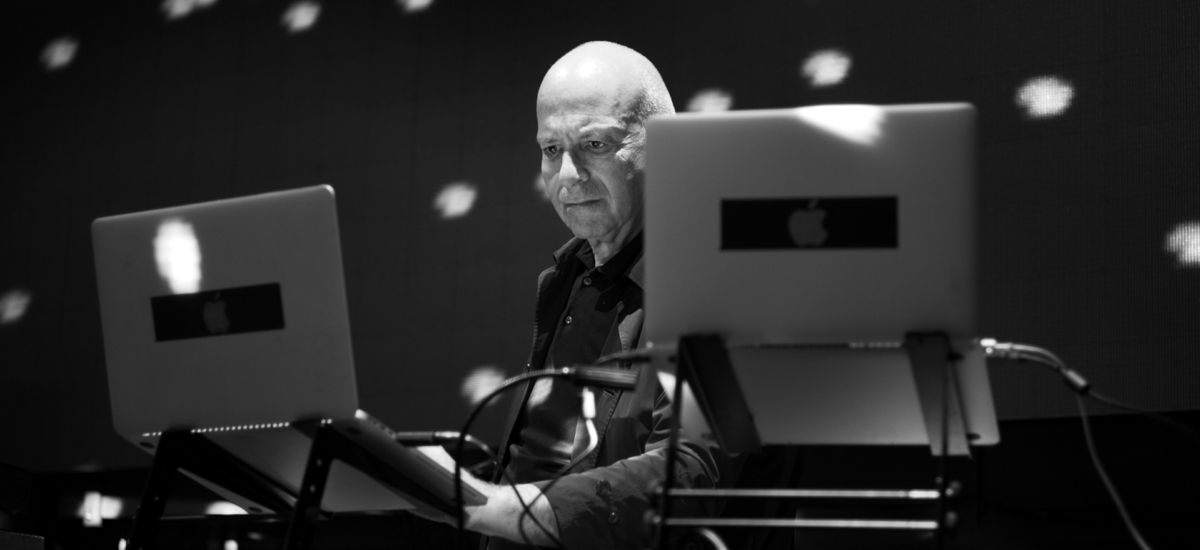
Daniel Miller’s career has been largely defined by being at the cutting edge of new developments in music. From his early interest in krautrock to the launching of now-legendary MUTE Records, and the signing of era-defining electronic music acts like Depeche Mode and New Order, Miller has always strived for that vital newness. When coming to recommence his dormant DJ career – at the age of 62 – Miller opted for TRAKTOR and the S4 controller as his medium. Native Instruments spoke to Miller about his use of TRAKTOR, his evolution as a DJ, and how to grade industrial shades of techno grey.
When did you first lay your hands on a pair of decks?
They were in a club in a ski resort in Switzerland called Zermatt. I’d left college and I worked in London for a couple of years and got sick of it, and I thought I needed to get out into the mountains and get some air. I love the mountains. The ideal job, I thought, would be if I were to be able to ski all day and work in the night.
So I went to this place I’d been to before and asked them if they had a job. This was in the summer, and they said “well, you can try out DJing”. I’d never DJed in my life before but I was a huge music lover. So, I had a couple of hours [DJing] in the sun with almost nobody there, and they said: “well, come back in the winter and we’ll give you some kind of job, maybe a DJ job or coat check.” I thought—whatever, I don’t mind.
And I got the DJ job—so I was kind of thrown in at the deep end. It was a tourist hotel, so it was the pop hits of the day really, from Abba to Status Quo to Deep Purple to James Brown to David Bowie. All right across the board really, and nearly all seven inch singles at that time as well.
What did it mean to be a DJ back then?
I think it was very different because in the place that I worked, there were two floors. The one that I worked on was all about making as much money as possible as much from not very many people. The other floor was much younger. The DJ there was a really proper DJ and he was really great. Obviously they didn’t have superstar DJs in those days but he was a proper DJ, and he also DJed in Ibiza at the time.
I felt like a complete amateur. I didn’t like all the music I played; I liked some of it. But what I really enjoyed was getting the crowd going. I didn’t really mind what I was playing at that point. If it works for the people there that’s what really gave me the satisfaction, I guess.
At the time I wasn’t involved in music at all professionally apart from doing that. I did it for two years, and when I came back to London I tried to do it. I got in contact with a couple of agencies but I wasn’t that enthusiastic, to be honest, because my real reason for being there was to be in the mountains. Being a DJ was the kind of the means to the end—and I was moving onto thinking about making music as well.
You’re many things: a DJ; a producer; a musician; a label owner. How does DJing fit into your world these days?
I didn’t properly DJ between 1975 and 2013, and then Regis—Carl O’Connor, a friend [of mine]—had a party at Berghain with Sandwell District and he invited me to play. I said: “You must be fucking crazy man!” He said: “Nah! You can do it! We’ll start you off at the beginning and [you’ll] just get get the hang of it.” And I did it and I enjoyed it so much that I thought—I’ve really got to do this.
A friend of mine is an agent and I asked her if she’d represent me and she said “yes”, and I do about 20-odd gigs a year maybe, and I do it purely because I love it so much. I just love it, because the nearest thing to it I’d ever got to was to play live. I just love interacting with an audience. I guess that’s what I really like, and I love the music as well of course.
What did you play at Berghain on that first night?
It was electronic dance music. I’d been to Berghain and I knew what the score was. I’d been doing an electronic music radio show in Berlin, for a few years so I had quite a lot of stuff that I could draw from. I was playing quite a lot of techno on that radio show as well, so it wasn’t alien to me in any way, not in the context of a club. I think I actually started off at the very beginning, when there was nobody there, with some krautrock actually. And then I went from krautrock into techno—not very smoothly! But yeah, playing in Berghain for your first ever DJ gig in 40 years or something is like playing your first football match ever at Wembley. It’s a bit crazy.
What does a Daniel Miller set sound like now?
I play techno only, partly because I love it, but also partly because I don’t have time to explore other areas of music that much in the DJ context. I love techno and I love the people around the scene. I know quite a few DJs in that scene because we used to have a label called Novamute with Richie Hawtin, Chris Liebing, Speedy J and Luke Slater, so I knew I knew quite a lot of people in that world and everybody was very supportive. It’s been great.
Where do you find your music these days?
I’m on a few promo lists. Friends send me music: in particular Chris Liebing and Regis send me tonnes of the music to listen to and I play some of that. I buy a lot of music as well from Beatport mostly, or Juno, or those kind of things. Of course, I don’t have nearly as much time as I’d like to explore music because I’ve got a day job which involves exploring music as well. I’d like to be more flexible in what I play, in terms of having more knowledge and more music. I’ve got tons of files but I’d like to have a lot more and I’d like to learn those tracks more.
I have a fairly flexible playlist when I start. It depends where I’m playing really. If I’m playing somewhere I’ve played before, then I kind of know the crowd and so I can put it in a direction. Some places I haven’t got a clue how it’s going to be. So I have various options to get things going and then just see what happens after that really.
Speaking of which, how do you go about organising your files and playlists for DJing?
Really badly. I don’t know how people do it actually. I do ask people and they just roll their eyes and say: “I’ve got no idea about it”. All I do is I set a playlist or a number of playlists. I tend to have like three or four folders for a night. One would say ‘early’; one might say up ‘mid’; one might say ‘dark’. So I’ve got a rough idea of what in those folders in terms of the moods. It’s all dark frankly! It should be ‘dark’, ‘darker’, ‘darkest’ really!
If there’s a lot of new stuff that I’ve got from a friend or from a promo list then I start going through that and stuff I like I’ll put it into a particular folder that I think would be good. Then I drag things in from previous playlists. I’ve got t a general folder called ’16s’ and I’ve got another general folder called ‘stabs’ which means more to me than probably anybody that would look at them. But it’s very clearly a different movement when you’ve got a 16s rhythm going, like a bass 16s rhythm, and when you’ve got a stab kind of rhythm going. So just those kinds of things.
Then I have a folder called ‘new’ which is maybe something I’ve got that I haven’t actually put into a playlist yet. So I have that all available and then just drag stuff in from one folder to another and whenever I need to go out of the folders, I have those other things to drag in. That sound even more organised than it really is!
I use the comments a lot as well. I’ve got a comments lists and I’ll make notes about maybe—oh that works really well with that track for instance—or such and such, and I’ll say ‘is it a 16?’ or ‘is it a stabby thing?’ or ‘is it dark?’ or ‘is it minimalist?’ or ‘is there a melody?’.
How long have you been using TRAKTOR, and how does it help you elevate your DJing game?
I’ve used it for the last four years. I started with it fairly soon after I started my new DJ career. I loved it immediately. It’s very intuitive. Then I got the S4 controller and it all kind of came together for me, and then later I got the S5 controller. What I love about TRAKTOR—and even more with the S5 —is that everything’s in front of you. You can see exactly what’s going on. You’re not running around all the time and that, for me, makes it really playable.
Another thing that they’ve done which I think is great is they’ve put the Ableton Link function into TRAKTOR, so that means you can link up stuff directly from TRAKTOR over a wireless network. So I’ve tried syncing my iPad to it, working with Arturia Spark and various other drum things. That’s another thing that I’m exploring: to have other sound sources outside of TRAKTOR using Link. But that’s another story.
I’m inspired by people like Chris Liebing and Richie Hawtin who have got all this stuff going onlike MASCHINE and stuff like that. I’m not in that world yet but that’s kind of where I’d like to be a little bit more. More of a performance, I guess.
Do you use it in a standard 2-channel setup or do you make use of the extra decks?
Four decks all the time. I quite often have four decks going at once, usually looping. I also use the new sequencer function and the remix decks—I use an F1 for that, at the side. So sometimes the fourth deck is a remix deck and sometimes it’s a track deck, depending on where I’m at.
Are you a heavy effects user?
I‘ve tried a lot of different effects things but it ends up usually being reverb and delay. I really love the ring modulator and the formant filter I use quite a lot as well.
What about looping?
Sometimes I’ll have four loops going at once and then I’ll take it out of loop on one track and it goes on a bit further and then I’ll take it a loop off another track, so it’s evolving in a kind of way. When I find four things that are really working together I just leave it for ages and let it go and let it run four loops at once, and maybe you do a little of EQ and effects on them to give it a bit of variation and dynamics—but when it’s actually locking in really well and working, it’s really satisfying. Go off for a Club Mate break!
I’m very keen on the cue points as well. I use the hot cues all the time. I was at Native Instruments the other day and I was saying: “come on, can’t I have 16 hot cues?” I always run out of them because I like jumping around a bit as well.
Do you use TRAKTOR stems?
A little bit. I really like the idea of the STEMS. We’ve actually made some as a label. There are a lot of things I’d like to expand in my sets that are really down to time to practice. Actually, what I really wanted to do was do my own tracks with STEMS, which I haven’t got around to doing yet.
Has your use of TRAKTOR fed into your remix work at all?
I’ve just done my first pure techno remix which I’m quite happy with which is for Jonty Skruff. He’s got an EP coming out through Egg’s label and I’ve just done a mix for that, and that’s kind of inspired to do more, even if it’s just for my own personal use.
When I was doing the structure of the mix I was thinking about the best way of starting and ending it. One thing I learned was that I should do the mix and I shouldn’t finish it; put it in TRAKTOR and play it out and work out where some bits are too long or some bits are not long enough in the club context and then re-edit it based on that—which I didn’t really do. I did a little bit of sonic tweaks before it got mastered based on what it played like.
I kind of treat it like another track that I would play by somebody else: I’ll put cue points in and I’ll jump around and loop depending on what the vibe is. They’re tools really. It’s not like I’m cutting up somebody’s great art—not in my case anyway! I think techno is an art, don’t get me wrong, but I think it’s designed to be used in that way as well.
Is it the pursuit of new technology that drives you in musical terms?
I’m excited by new music and I am excited about how that music is made and I’m excited about how that music is presented. The thing that excites me is the music, and then how the technology serves that music is the next thing, I guess. I used to be on the advisory board of Native Instruments for quite a long time, and it was exciting to be part of that process early on discussing projects and things like that. So I do like that side of it very much, but in the end you can have the best technology in the world, but if the music is shit it doesn’t make any difference.
photo credits: Diane Zillmer
Mute: A Visual History – is available to order now.











